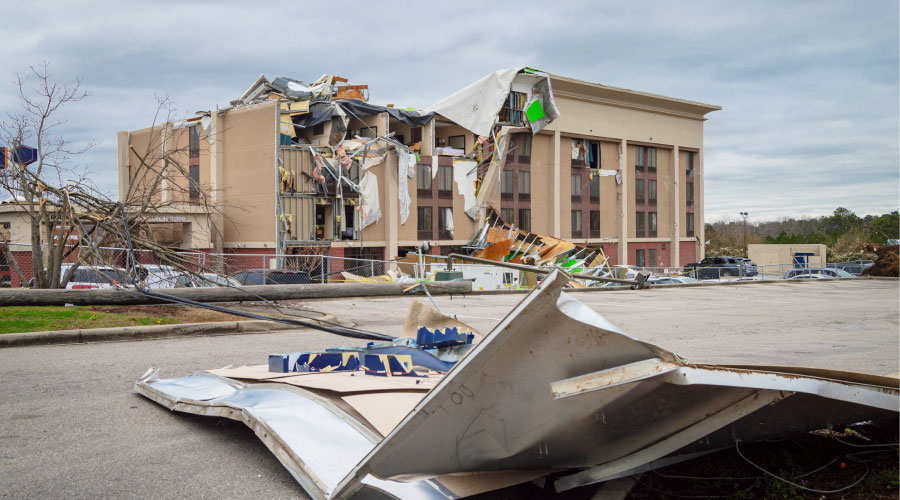Emergency Preparedness: Path to Safety
An emergency plan is more than just paperwork. A carefully prepared and regularly practiced plan might be the difference between life and death
Recent history shows that fire can strike any type of building with devastating consequences:
n On Jan. 29, 2003, in Kinston, N.C., a dust explosion and subsequent fire at the West Pharmaceutical Services manufacturing plant killed six workers and injured 38 others, including two firefighters. Direct property loss was reported at $150 million.
• On Feb. 20, 2003, in West Warwick, R.I. 100 occupants perished in a fire ignited by indoor pyrotechnics during a rock concert at The Station nightclub.
• On Feb. 26, 2003, in Hartford, Conn., 16 patients died in an early morning nursing home fire.
• On Sept. 25, 2003, in Nashville, 16 patients died in a catastrophic nursing home fire.
• On Oct. 17, 2003, in Chicago, a fire in the 36-story Cook County Administration Building killed six occupants and injured a dozen others.
• On Jan. 25, 2004, in Greenville, S.C, an early morning fire that started on the third floor of a five-story motel killed six occupants, including a 15-month-old boy.
This is just a small sample of the significant fires that have occurred in recent years. Other than the two nursing homes, the fires happened at different types of buildings. No matter what type of facility, it’s important to have an emergency plan, and it’s even more important to practice implementing the plan on a routine basis.
In addition to fire, planning should also consider other emergencies, such as weather events and other natural disasters; hazardous materials release, both inside and outside the building; workplace violence; and terrorism. The principles applied to emergency planning for such nonfire events are similar to those for fires; however, the location of the incident relative to the building will affect the actions needed to stay safe.
Evacuation or Defend-in-Place
The two basic occupant-protection strategies are evacuation — either total or staged — and defend-in-place. Determining which strategy is most appropriate depends on a variety of factors, including the type of incident, the occupants’ evacuation capabilities, how the building is constructed, and the presence of fire protection and other life safety systems.
Total evacuation is relatively straightforward: An alarm sounds, or other means of emergency notification is activated, and all building occupants simultaneously exit the building.
Staged evacuation is a bit more complicated. Where staged evacuation is used, the location of the fire or other incident in the building is identified, and only those occupants who might be immediately threatened are notified to leave the building. The remaining occupants are typically notified that an emergency has been reported in the building and they are to await further instructions.
Staged evacuation is commonly used in high-rise buildings. An advantage of staged evacuation is that only those occupants in immediate danger are directed to use the exit stairs. The fewer people in the stairs, the more quickly occupants can exit, yielding shorter queues at the stair entrances. Staged evacuation requires continuous monitoring of the incident to determine if the evacuation of additional occupants will be necessary. The fire department or other public emergency response agency will usually make this determination.
Both total- and staged-evacuation assume the fire or other emergency is located within the building. Both strategies also assume the occupants are physically able to get out of the building without assistance.
That isn’t always the case. Consider, for example, a hospital where patients are confined to their beds. In addition to being unable to evacuate, many patients might be attached to life-sustaining equipment, and their removal from the building might put them in grave danger. For these reasons, hospitals are designed to accommodate the defend-in-place strategy, whereby occupants are relocated to a safe location on the same floor rather than being evacuated. The safe locations are created by subdividing the floors of the building into two or more smoke compartments or fire compartments, separated by specially constructed walls designed to limit the transfer of smoke or restrict the spread of fire from one side to the other.
Another example of where the defend-in-place strategy might be more appropriate than evacuation is during a weather emergency, such as a tornado. Occupants will likely be safer if moved to a protected location, away from windows, inside the building rather than outside. An area such as the building core — typically the center of the building where elevators are commonly located — or a basement level might be considered a safe location for such an event. While this might seem like common sense, it’s important to document the appropriate actions for various emergency scenarios and, more importantly, to practice them on a regular basis.
Facility Fire Protection and Life Safety Systems
The emergency action specified by an emergency plan will depend not only on the type of event occurring, but also on the building and its protection features. Many construction and safety codes, such as NFPA’s Life Safety Code® (NFPA 101®), and the recently developed Building Construction and Safety Code® (NFPA 5000®), mandate safety features, such as automatic sprinkler systems and fire alarm systems, depending on the use and size of the building. Other life safety features can include emergency lighting and standby power, portable fire extinguishers, smoke management systems, elevator controls, fire-resistive construction and means of egress.
Automatic sprinkler systems have a tremendous success record. NFPA has no record of a fire killing three or more people in a sprinklered building where the sprinkler system was not impaired, for example, by a catastrophic explosion or intentional disabling of the system. The presence of automatic sprinklers should be a primary consideration if the staged-evacuation or defend-in-place strategies are to be used in response to a fire.
When an emergency occurs, there needs to be a method to communicate with the building occupants. In facilities that employ the total-evacuation strategy, the communication method might be as simple as a horn sounding and strobe lights flashing when the fire alarm activates. If staged-evacuation or defend-in-place is used, a more sophisticated means of communication is required. Larger buildings using these protection strategies are frequently equipped with voice-communication fire alarm systems, which allow either a live or recorded voice announcement, or both, to provide direction to occupants. The message may say occupants should remain in place and await further instructions, move to a designated safe location in the building, or evacuate the building to the outside. The person responsible for selecting the message should have a clear understanding of the emergency and the authority to take the necessary actions for occupant safety. All of this should be clearly spelled out in the facility’s emergency plan.
A building’s means of egress is perhaps the most important, and often the most overlooked, life safety feature. Storage should never be permitted in exit stairways; they must be kept free and clear at all times. Any locking mechanism that might prevent an exit door in any part of the building from being used in an emergency should be removed immediately. Doors on exit stairways must never be blocked open using wooden wedges or other nonapproved means; they need to be in the closed position to ensure the stairway is free of smoke and heat during a fire. Under no circumstance should an exit door be locked or otherwise blocked against egress travel.
Many people have died in fires because exits were either locked or otherwise not properly maintained. Periodically checking a building’s egress systems costs virtually nothing and can go a long way toward ensuring occupant safety.
The facility’s emergency plan should describe how the egress systems are to be used for various emergencies, and occupants need to be familiar with all the building’s exits, especially those not used on a daily basis. Their comfort level can be increased by holding periodic emergency drills, both announced for training purposes and unannounced for determining whether more practice is needed.
Understanding the building’s safety systems is critical to developing an effective emergency plan. It is also important to ensure that the systems are properly maintained so that they will operate during an actual emergency. NFPA develops and publishes numerous model codes and standards that address the minimum requirements for testing and maintaining these systems. For more details, visit NFPA’s Web site.
Not only can a building’s occupants be at risk if system maintenance is neglected, but the organization might also face fines and incur substantial liability for not meeting minimum code requirements or a nationally accepted standard of care. A local fire department or state fire marshal’s office can provide guidance on the minimum legal requirements.
Decision-Making in Emergencies
Determining the best course of action for building occupants in an emergency is a high-stakes, low-frequency scenario. The person responsible for making the decisions will be greatly aided by having a plan in place that the occupants know and have practiced. The best emergency responders know that no matter how prepared they are, they must always expect the unexpected. The person responsible for making decisions during emergencies needs to be cool under pressure, flexible to adapt to changing needs and have access to whatever resources are necessary to manage the incident.
In some cases, the initial decisions are made automatically by building systems. For example, a fire starts in a waste basket in a restroom on the fifth floor of a 12-story office building and triggers a sprinkler and the fire alarm system. The fire alarm system, which has been programmed for staged evacuation, makes an automatic voice announcement to the fourth, fifth and sixth floors, directing occupants there to evacuate using the nearest exit stairway. Then an automatic message is broadcast to the other floors, advising occupants that a fire has been reported and that they should await further instructions.
In this example, the occupants directly exposed to the fire threat are instructed to leave the building. Emergency responders can then investigate the cause of the alarm and determine if additional evacuation is necessary. Most likely, responders would discover an extinguished trash fire and no additional evacuation would be necessary. If the situation deteriorates, however, the decision-maker needs to be ready to change the game plan. For this reason, the responsible staff must be familiar with the building’s communication system and have the ability to override any automatic messages with manual voice announcements.
When an emergency other than fire occurs, or there is no automatic fire detection system in the building, a designated individual will need to make decisions. The emergency plan should specify not an individual, but rather a position or job function, such as the security shift supervisor or building engineer, to be the designated decision maker. When the individual in the designated position is out sick or on vacation, another individual can be assigned to assume the responsibilities. Whatever the process, it should be well documented in the plan, and all affected individuals should clearly understand their responsibilities.
Making the Right Choice
To select a course of action, the decision maker needs to evaluate all the available information. Sources of information can include: indicators on alarm panels; reports from security staff; reports from other building occupants; radio and television reports on major events outside the building; and the individual’s own sensory observations. With any course of action there is a desired or anticipated outcome. For example, if a tornado is approaching, the course of action might be to relocate the occupants to a safe location in the building. If the safe location is compromised by the weather event, the course of action must be modified. Again, the ability to change with the situation is an important trait for the decision maker.
Building occupants need to be able to trust the decisions made for them during an emergency. Confidence is earned over time. One step is to make it clear that safety is of primary importance to senior management. Another step is conducting routine training and holding periodic evacuation and relocation drills as appropriate for the building. When occupants see that the decision maker is well-trained and has a good understanding of the building’s safety features, and that clear plans are in place for varying circumstances, occupants are more likely to trust the individual and directives are more likely to be followed.
The Facilities Executive’s Role
The facilities executive’s responsibilities include knowing the building’s safety features and performance limitations in various emergencies; ensuring an emergency plan is in place; ensuring the building and its life safety systems are properly maintained; and providing training to any in-house emergency team and the general building population.
The emergency plan should be a documented collection of actions intended to reduce the impact of fire and other emergencies on the building and its occupants. The plan should address the following:
- Prevention: includes fire prevention measures, security and other measures
- Detection: automatic systems and other methods used to identify when an emergency either exists or is pending
- Notification: methods used to inform both building occupants and emergency responders of the emergency
- Evacuation or relocation measures: procedures to remove occupants from exposure to the emergency
- Control: methods to minimize adverse impact of the emergency event on the building and occupants
- Recovery: methods to restore operations following the event
- Public relations: a plan for providing consistent information to the media
It’s important that the plan be well-organized and easy to follow; during an emergency, the information it contains must be quickly accessible. The information must also be easy to understand. Most importantly, the plan should be used routinely by conducting emergency drills. The plan’s effectiveness can also be evaluated by implementing it for less serious, non-threatening incidents.
The objective of any drill should be to determine whether occupants follow the directions given for a specific incident with no unnecessary delays. If not, the results should be analyzed to determine if the fault lies with the occupants or the plan. It is vital that all occupants participate, including senior management. Top executive visibility during drills and training will go a long way toward enhancing a pro-safety attitude by all.
Where to Go From Here
If a facility lacks an emergency plan, the first step should be to formulate an action plan to develop and implement one. Preparing the plan will likely require input from other staff, and should also involve local emergency responders, such as the fire department. Once the plan is developed, it should be thought of as a living document that can, and should, change over time as conditions change, such as the building’s physical configuration or the characteristics of the occupants.
A great deal can be learned from the emergency planning that occurred following the 1993 World Trade Center bombing. It’s reasonable to assume that hundreds, if not thousands, of lives were saved on Sept. 11, 2001, thanks to the plans that were developed and exercised in the years between the two terrorist attacks.
Don’t be caught by surprise. Have a plan in place and practice it often. It just might make the difference between life and death.
Gregory Harrington, P.E., is principal fire protection engineer in the building fire protection and life safety division of the National Fire Protection Association.
About NFPA
There are many Internet sites with valuable information about lighting. Some of the best include:
The National Fire Protection Association has been a worldwide leader in providing fire, electrical, building and life safety to the public since 1896. The mission of the international nonprofit organization is to reduce the worldwide burden of fire and other hazards on the quality of life by providing and advocating scientifically based consensus codes and standards, research, training and education.
|
Related Topics:











